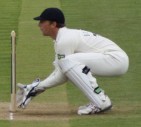South Africa’s middle order holds the key
Paul Wood |
The excitement and anticipation continues to build ahead of this Thursday’s mouth-watering, if ridiculously abbreviated, Test series between England and South Africa.
James Anderson and Dale Steyn are understandably in demand from the media as the journalists seek a headline comment from two men at the peak of their profession. The supporting attacks on both sides are also receiving ample column inches as the focus on which team possesses the more potent firepower intensifies. Strong cases can be made for either attack, but perhaps in home conditions and with the South African attack maybe a touch under-cooked, England are seen to have a slight advantage which means the spotlight will quickly shift to the preparation and skills of the tourists batsmen.
They will be led by their imposing opening batsman Graeme Smith, who has enjoyed much success in England on previous tours. Who can forget his pair of double hundreds back at the start of the 2003 series, certainly not Nasser Hussain, or his hundred at Lords in 2008 when his side had been asked to follow-on, or perhaps the most impressive of the lot, his 154 not out at Edgbaston during that 2008 series successfully leading his side to the 281 run target that was set to clinch South Africa their first series victory in England since 1965. He has pedigree in this country, no doubt, but surely Jimmy Anderson will fancy a crack at Smith with the new ball with his unorthodox and at times very ugly technique where he constantly looks to work the ball through the leg side from deliveries on and outside the off stump. Anderson has improved further since that last contest and with his ability to bowl a variety of deliveries at will without compromising accuracy, Smith will have to work even harder for his runs in this series.
England can still find positives in Smith’s excellent average in this country – currently standing at 72.20 – as he has been dismissed on eight occasions (out of 17 innings) for less than 20. The key clearly is for England to remove him before he gets set, or it could be a long day, or two, in the field.
For me, though, the strength of South Africa is in the middle order, the contrasting styles of Hashim Amla, Jacques Kallis, and AB de Villiers.
Amla took his time becoming accustomed to the demands of Test cricket, his technique was seen as being too unorthodox and having too many chinks to have any real success at the highest level. It took till his 31st Test match for him to average over 40 for the first time, but he has now grooved his own style and even if it isn’t as pleasing on the eye as many batsmen, it has become exceptionally effective.
His driving off the front and back foot through the offside are more punchy than flowing with a lack of any real follow-through, timing being paramount. His wrists really come into play through the legside as you may expect from a man of Indian descent, able to get real power into his flicks off his legs and hips. He has the temperament to bat long periods and rarely gets flustered out in the middle.
I could not say anything about Kallis that hasn’t already been said, he is a real legend of the game and we should enjoy Kallis the batsman/bowler/slip fielder extraordinaire while he is still playing. Unfortunately for Kallis the batsman he hasn’t enjoyed England as much as he has everywhere else in the world. Just as his inability to reach 200 in a Test innings was seen as an anomaly (a feat he finally achieved in his 143rd Test match, then repeated it again seven Tests later!) so too is his poor record in England – he averages just 29.30. When compared to his overall Test average of 56.78 it shows how below-par he has been, but is this to be another record he is to set straight, and emphatically so ?
Kallis has few weaknesses with the bat in hand, and certainly none that bowlers have managed to exploit on anything like a consistent basis. His orthodoxy can only be admired. Bob Woolmer’s publication – The Art of Science and Cricket – uses pictures of Kallis demonstrating how each shot should be correctly played. It is not unrealistic to suggest that you can take snapshots of any Kallis innings playing any particular stroke and use it in a similar educational manner. If England can continue to silence Kallis it will go a long way to keeping South African totals manageable.
Now onto arguably my favourite batsman outside of England – AB de Villiers. If Amla and Kallis can be described as reliable and solid, then de Villiers brings the real X-Factor, the ability and confidence to play any stroke and light up a stadium with a typically flashy cameo. Yet this is Test cricket and de Villiers will need to find the right balance and tempo to his innings having been such eye catching form in the shorter forms of the game of late. His Test record, however, is also very respectable averaging just under 50.
How de Villiers manages to combine his wicket-keeping duties, following the terrible incident with Mark Boucher, with his batting at number five may be key and the management will be eager not to hinder his impact in his primary role. With the bat de Villiers is comfortable cutting, pulling, or driving the quicker men just as much as he is using his quick feet to skip down the track to smash or work the slower bowling around.
In a recent interview de Villiers talked of returning to absolute basics in order to find form, and it is from this platform that he can tee off with a wide range of strokes. He is a more mature cricketer these days so he’s unlikely to attempt to play every shot he possibly can, he can accumulate by working the gaps and be patient in waiting for a loose delivery. He will always maintain a positive intent so rarely misses an opportunity to find the boundary. Purely because he plays more shots than others in the South African line-up he does look more vulnerable at times, but the danger is he can have the board ticking at a healthy rate.
In recent years England have bowled with discipline in an attempt to stop sides scoring at anything like four an over. Fields that Andrew Strauss sets may be viewed as defensive but they are all part of the bigger picture to dry up the runs, frustrate, and thus induce batsmen into injudicious strokes. De Villiers may challenge Strauss’ theory, he will not allow England to stop him from scoring and will put pressure back on the bowlers and captain Strauss.
As well as the batsmen already mentioned, Alviro Petersen, Jacques Rudolph and JP Duminy should not be overlooked or under-estimated and with Boucher now retired, there is scope for Gary Kirsen to select all of these batsmen and give his side a powerful look on paper. Both Petersen and Rudolph have experienced English conditions, Petersen with Glamorgan last season and a spell with Essex this season, and Rudolph having spent many years at Yorkshire (and at Surrey this season).
England are rightly number one in the world on the eve of this series, and if they are to remain in that position, South Africa’s middle order must be tamed. Flower and Strauss will have meticulously planned for each batsmen (they’ve had nothing else to do with the recent weather!) now it’s over to Anderson, Broad et al, to successfully execute them.




Much has been talked about in the build-up to the England-South Africa series with regards both bowling attacks, but England’s attack will be made to work very hard by the visitors quality middle order.
Comment by Woodster | 12:00am BST 18 July 2012
I would agree with that. Not bad when you’ve got Graeme Smith opening either. In terms of batting, I would say South Africa are definitely stronger, although England’s batting line-up goes far down.
Comment by benjy | 12:00am BST 18 July 2012
Given that England’s bowling-attack is yet to get their first South African middle-order wicket in the series, I think Woodster was right on the money.
Comment by weldone | 12:00am BST 23 July 2012
woodster generally has good quality analyses
Comment by smalishah84 | 12:00am BST 23 July 2012